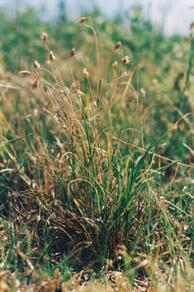

Genus: Buchloe
Species: dactyloides
Parts Used: for turf and feed purposes

Buffalo grass is a very hardy grass and grows mostly in the North American prairies. The North American prairies lie in the middle of the continent and have a dry climate during the summer, and a very cold and windy climate in the winter.
Buffalo grass is a warm-season, native, perennial shortgrass. It grows between 2 and 5 inches (5-13 cm) tall and spreads out between six feet and 12 feet (3-4 m). It has a round hollow stem with gray, green curly leaves. The leaves are 1/10 " wide and 2" long.
In winter it turns tan and in the autumn it turns lavender. It is very drought resistant. In dry seasons it gets brown, and stops growing, and goes dormant. It is also heat and cold resistant.
Buffalo grass has both male and female plants. The flower stalks are 4 to 8 inches (10-20 cm) tall The female seed head of buffalo grass grow in clusters of three to five hairy spikelets. The tiny clusters of yellow to golden male flower of buffalo grass grow about 2 inches (6 cm) above the blades. The burs on buffalo grass seeds don't cling to animal fur for very long and the seeds fall close to the parent plant.
Buffalo grass sends out many thin roots that can reach 5 feet below the ground, forming a dense sod. Seventy percent of the roots are in the first 6 inches (15 cm) of soil. Buffalo grass also reproduces through stolons.
Buffalo grass is one of the most important grasses on the short grass prairies. Both livestock and white-tailed deer, buffalo, pronghorns, jackrabbits and prairie dogs use it as forage. It was the main source of food for the buffalo when huge herds roamed the prairies. Mountain plovers build their nests in buffalo grass.
Fires set by lightning strikes often swept across the prairies, and became an important part of the ecosystem. Native Americans used to set fire to various parts of the prairie. Grassland fires move quickly and don't stay in one place for very long. Buffalo grass has adapted to grassland fires and sometimes grows better after a fire. The actual growing parts of buffalo grass are protected from fire by soil. It sends out new shoots from the roots or bottom of the unburned stolon buds. Seeds are also protected from fire by the burs they are enclosed in.
Besides being found on the prairie, buffalo grass is used in meadows, and for turf grass. It's ornamental flowers can look pretty no matter where it grows.
2000
Bibliography:
Loewer, Peter. (1995). Better Homes and Gardens Ornamental Grasses., Desmoine, Iowa: Meredith Books, Round Table Press, Inc.
Loewer, Peter. (1988). Ornamental Grasses - Brooklyn Botanic Gardens. Ed, Barbara B. Psch. Brooklyn, N.Y: Editorial Committee of the Brooklyn Botanical Gardens, Inc.
Weigel, Martene. (2000). Encyclopedia of Biomes. Gale Group.
World Book Encyclopedia, ed., The Plant World. (2000). Chicago. Ill:World Book , Inc.
"Grassland", http://www.Britannica.com/
"Native Warm-Season Grasses", http://clay.agr.okstate.edu/forage/images/nativewsgrasses.htm
"Buchloe dactyloides", http://www.fs.fed.us/database/feis/plants/graminoid/bucdac/, (2002).